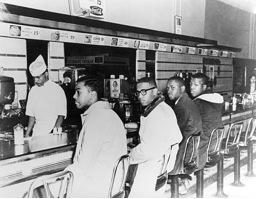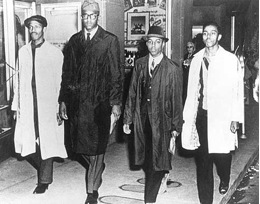
Greensboro Sit-Ins, 1960
By Sara
 Throughout all of the Civil Rights Movement the protesters protested nonviolently. A great example is the Greensboro, North Carolina sit-ins. This all started when four African-Americans of North Carolina Agriculture and Technical State University sat at an all white lunch counter at a Greensboro Woolworth’s store. As many people have said before they took a stand by sitting down. These people started their protest because of four African-American college students who learned they could make a difference like Mohandas Gandhi and Freedom Ride participants through nonviolence. Ezell Blair and Joseph McNeil were two of the young men who participated in the very first sit-in.
Throughout all of the Civil Rights Movement the protesters protested nonviolently. A great example is the Greensboro, North Carolina sit-ins. This all started when four African-Americans of North Carolina Agriculture and Technical State University sat at an all white lunch counter at a Greensboro Woolworth’s store. As many people have said before they took a stand by sitting down. These people started their protest because of four African-American college students who learned they could make a difference like Mohandas Gandhi and Freedom Ride participants through nonviolence. Ezell Blair and Joseph McNeil were two of the young men who participated in the very first sit-in.
Before the first sit-in could be executed the students who were going to take part had to learn many things. They went to a concert where other African-Americans played rude roles and they learned not to act like that. The participants also learned to perform nonviolence because the white people could do things like throw food to anger them. All students learned these skills and were able to perform them successfully. Along with the “training” they also had to plan. They first planned to go to Ralph Johns’ store so that Johns’ would call the newspaper and would start getting publicity. Then on Monday, February 1st, 1960 they were at Woolworth’s store ready to begin.
 February 1st, 1960 was the first day of the protest. The four A&T students casually sat down at the Woolworth only-white lunch counter and politely asked for service. They were refused service and were requested by the manager to leave the premises. As soon as they left they told the leaders at A&T what happened. The next day 29 well dressed men and women from North Carolina Agriculture & Technical State University sat at the only-white lunch counter. As the protest continued, more and more people joined. By Saturday, February 6th the protest included fourteen hundred students and spread to many other stores with segregated lunch counters.
February 1st, 1960 was the first day of the protest. The four A&T students casually sat down at the Woolworth only-white lunch counter and politely asked for service. They were refused service and were requested by the manager to leave the premises. As soon as they left they told the leaders at A&T what happened. The next day 29 well dressed men and women from North Carolina Agriculture & Technical State University sat at the only-white lunch counter. As the protest continued, more and more people joined. By Saturday, February 6th the protest included fourteen hundred students and spread to many other stores with segregated lunch counters.
There were people who believed this was wrong and fought back at the protesters with violence. They would go in the store and sit down just to harass the protesters by spitting and using inappropriate language at them. In one case a protester's coat was set on fire. These things only made the protest seem better and convinced people to agree with them. Protesters were often arrested by the police as well. Someone also threatened to bomb the store to cut the protest short. The consequences were bad but helped bring about change.
The four students changed the lunch counters. In less than a month, their protests brought partial integration and showed the rest of the U.S. how the South treated African-Americans. This was one of the things that helped change our segregated way of life. They proved that the simplest form of protest was the most effective. They also proved that even the smallest things can change the world. Although they were treated harshly they made a change. This helped show that we can make a stand by sitting down.
Article information
Murray, Jonathan. "Greensboro Sit-In." not given . not given. not given (not given): 1. Web. http://www.northcarolinahistory.org/encyclopedia/299/entry.
Powledge, Fred. We shall overcome. First. not given. New York, New York: Charles Scribner's Sons. 1993, 214. Print.
First picture
Woolworth sit-in." Separate is not equal. Web. 11/22/11. http://americanhistory.si.edu/brown/history/6-legacy/freedom-struggle-2.html.
Second picture
"Greensboro first day." Separate is not equal. Web. 11/22/11. http://americanhistory.si.edu/brown/history/6-legacy/freedom-struggle-2.html





